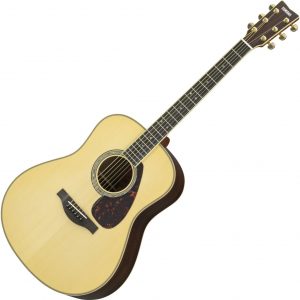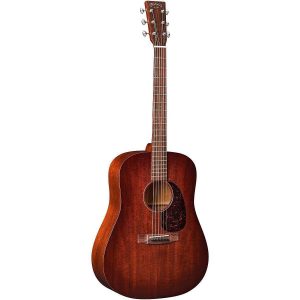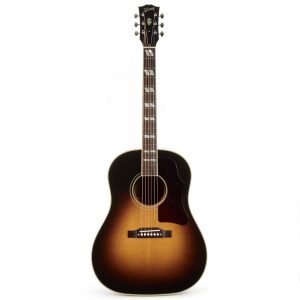Sigma DM-1ST
$216.99
Experience superior sound quality and craftsmanship with the Sigma DM-1ST acoustic guitar, the perfect choice for beginner and experienced guitarists alike.
Compare
Description
The Sigma DM-1ST is an acoustic guitar that is perfect for both beginners and advanced players. It is part of the Sigma line of guitars that have gained popularity in recent years due to their quality build, great sound, and affordability.
The DM-1ST has a solid Sitka spruce top, which is the most commonly used wood for guitar tops because of its excellent tonal qualities. The back and sides of the guitar are made of mahogany, which adds warmth and depth to the sound. The guitar has a full-bodied, well-balanced sound that is perfect for strumming and fingerpicking.
The neck of the DM-1ST is made of mahogany and has a comfortable C-shaped profile that is great for playing chords and lead solos. The fretboard is made of Indian rosewood, which is known for its smooth feel and great sustain.
The guitar has a natural satin finish that shows off the beautiful wood grain and gives it a classic, understated look. The hardware on the guitar, including the tuners and bridge, are made of durable materials that provide stable tuning and easy string changes.
In addition to its great sound and quality build, the DM-1ST is also very affordable. It is perfect for beginners who are just starting to learn how to play guitar, as well as advanced players who are looking for a high-quality instrument that won’t break the bank.
Overall, the Sigma DM-1ST is an excellent acoustic guitar that offers great sound, quality construction, and affordability. Whether you’re a beginner or an advanced player, this guitar is worth considering if you’re in the market for a new instrument.
Sigma DM-1ST properties
| Product name |
DM-1ST |
| Brand |
Sigma |
| Type |
String Instruments |
| String Instruments |
Acoustic Guitar |
| String Type |
Nylon |
| Built-in Microphone |
No |
| Cutaway |
No Cutaway |
| Size |
4/4 |
Frequently Asked Questions:
How do I tune my new Sigma DM-1ST acoustic guitar?
Congratulations on your new Sigma DM-1ST acoustic guitar! To properly tune your guitar, you'll need a tuner or a digital device that can detect and display the pitch of notes. Here are the steps to tune your guitar using the A4 (or 440 Hz) reference note:
Step 1: Locate the Low E string (the thickest string) on the headstock of your guitar. This is the bottom-most string, closest to the floor when you're seated playing the instrument. Using an electronic tuner or a smartphone app that can detect pitch, play the Low E string and adjust the tuning peg until the note matches A4 (or 440 Hz) reference note.
Step 2: Move on to the adjacent string, which is the A string. Adjust the tuning peg on the headstock of your guitar until the note matches the reference note for A. Continue this process, moving from the Low E string to the High E string (the thinnest string), checking each string's pitch against the reference note for that particular string.
Step 3: After tuning all six strings on your Sigma DM-1ST acoustic guitar, play a chord or a few notes to make sure they sound in tune with each other. If you notice any notes out of tune, adjust the tuning pegs until they match the reference note.
Remember that guitars tend to lose their tuning over time, especially when exposed to temperature changes or humidity fluctuations. To maintain your guitar's tuning, it's best to store it in a stable environment and use a humidifier during periods of extreme dryness.
What type of preamp does the Sigma DM-1ST acoustic guitar feature?
The Sigma DM-1ST acoustic guitar features a piezoelectric pickup system.
What is the unique feature of the Sigma DM-1ST digital guitar and how does it enhance the user's experience compared to traditional acoustic guitars?
The Sigma DM-1ST digital guitar sets itself apart from traditional acoustic guitars with its built-in microphone and preamp system. This feature allows musicians to amplify their sound without losing the natural resonance and tone of an acoustic instrument. The preamp also provides a variety of effects, such as reverb and chorus, further enhancing the user's creative options during live performances or studio recordings. Additionally, the guitar has a headphone output, making it possible to practice silently without disturbing others around you. Overall, the Sigma DM-1ST offers an unparalleled experience for musicians who want the benefits of an acoustic guitar with the versatility and convenience of digital amplification.
What is the precise procedure for adjusting the tremolo arm of a Sigma DM-1ST acoustic guitar to eliminate excessive pitch drop and maintain optimal string tension?
1. Locate the tremolo spring claw**: On a Sigma DM-1ST, the tremolo system is called the "Tremolux" and is located at the base of the bridge. The spring claw is the small metal piece that holds the tremolo springs in place. Identify the problem**: Excessive pitch drop is often caused by too much tension on the high E string or not enough tension on the low E string. To eliminate excessive pitch drop, you need to adjust the string tension. Remove the old strings**: Before adjusting the tremolo arm, it's a good idea to remove the old strings and replace them with new ones. This ensures that any adjustments will be based on optimal string tension rather than worn-out strings. Adjust the bridge height**: To maintain optimal string tension, you need to adjust the bridge height so that it is level with the nut. Use a bridge adjustment screw or a shim to achieve this. Loosen the tremolo arm screw**: Turn the tremolo arm screw counterclockwise until there's almost no resistance. This will give you maximum flexibility when adjusting the string tension. Tighten the high E string**: Adjust the high E string so that it is slightly looser than optimal. You can do this by turning the tuning peg clockwise while keeping the low E string at its optimal tension. Adjust the tremolo arm**: Turn the tremolo arm screw clockwise until you feel a slight resistance. This indicates that the string tension has increased and pitch drop should be eliminated. Check the string tension**: Use a tuner to check the string tension of both the high E and low E strings. You should aim for a slightly higher tension on the low E string than on the high E string. Fine-tune the tremolo arm**: If there's still excessive pitch drop, you can fine-tune the tremolo arm by turning the screw clockwise or counterclockwise until the desired level of pitch stability is achieved. Secure the tremolo arm screw**: Once you've adjusted the tremolo arm to your liking, turn the screw clockwise to secure it in place. Tighten the low E string**: Finally, tighten the low E string so that it's at its optimal tension. Check the guitar**: Play a few chords and check if the pitch drop has been eliminated. If there's still excessive pitch drop, you may need to repeat steps 6-10 until you achieve the desired level of pitch stability. By following these steps, you should be able to adjust the tremolo arm on your Sigma DM-1ST acoustic guitar to eliminate excessive pitch drop and maintain optimal string tension.
Can you explain how to properly adjust the action and string height on a Sigma DM-1ST acoustic guitar to optimize its playability and sound quality?
**
- **Action:** This refers to how high or low your strings sit above the fretboard when pressed down against it. String Height:** This is related but more about the height of the strings at their highest point (beyond the nut) when not pressed. Tools Needed:**
- A set of Allen wrenches for the bridge and nut adjustments. A string winder, if you decide to change strings. A guitar tuner for precise tuning. Adjusting Action:**
1. Check Current Setup:** First, check your current setup by playing around with fretting different notes on the lower end of the fretboard. The action should be low enough that you can easily play without pressing too hard but not so low that strings buzz. Bridge Adjustment:** Use an Allen wrench to adjust the bridge in small increments (about 0. If your action is high, you'll need to lower the bridge. However, if it's too low and buzzing occurs when playing on the higher frets, you might need to raise it slightly. Nut Adjustment:** The nut also affects string height, especially at the first few frets. Adjusting the nut involves carefully moving its position using an Allen wrench or by replacing it entirely with a lower setup. This should be done very carefully as over-adjustment can significantly affect tuning stability. String Height Checkpoint:** After adjusting the bridge and nut, play each string across its full range to ensure there's no buzzing anywhere. If you notice any buzzing at higher frets, you might need to adjust the action slightly higher for those strings. Adjusting String Height (Action):**
1. Lower Strings First:** It's easier to lower the action than it is to raise it without affecting tuning stability. Start by lowering the low E string first, as this typically has the most impact on overall playability. Small Increments:** Lower your action in small increments and re-check with a tuner after each adjustment to ensure you're not introducing tuning issues. Additional Tips:**
- **Monitor for Buzzing:** Check for buzzing at different points of playing, especially higher up the fretboard. Check Tuning Stability:** After making any adjustments, check your guitar's tuning stability over time, as adjustments can sometimes affect the way strings vibrate and thus require re-tuning more frequently. Final Check:**
- Once you've made adjustments that seem optimal for playability and sound quality, do a thorough check of your work by playing each string across its full range while monitoring tuning stability and action height. Adjusting the action and string height can be delicate because it affects both the guitar's playability and its ability to produce clear notes. It requires patience but can significantly enhance the user experience for players.
Before you buy Sigma DM-1ST










Reviews
There are no reviews yet.